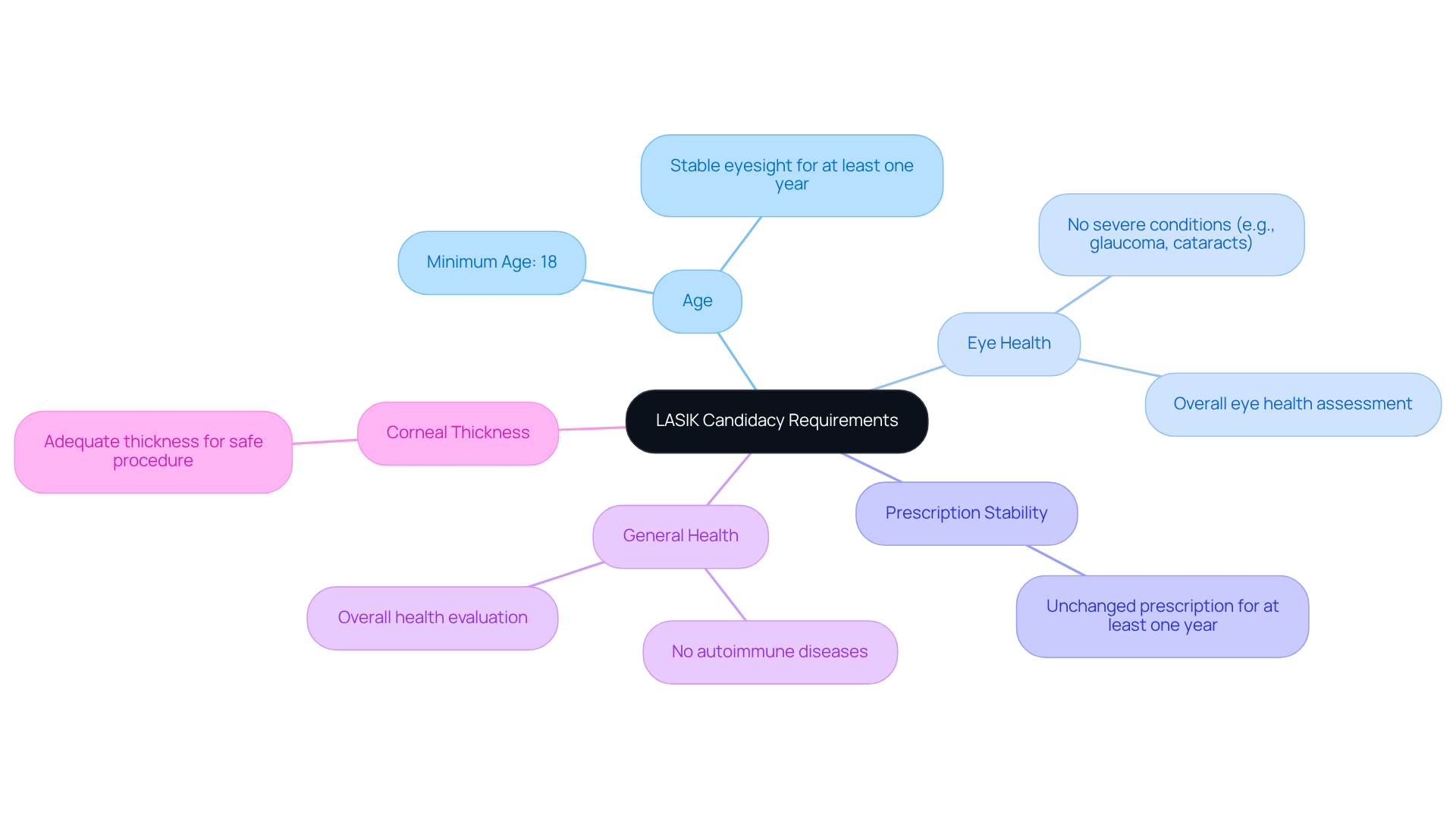Posted by: Northwest Eye in General on June 18, 2025
Overview
We understand that achieving 20/15 vision through LASIK is an important goal for many individuals. To help you on this journey, it’s essential to follow specific preparation and recovery steps. This includes:
- Thorough pre-operative assessments
- Avoiding contact lenses prior to the procedure
- Adhering to post-operative care guidelines
These measures, when combined with a comprehensive evaluation by an ophthalmologist, significantly enhance the likelihood of successful outcomes and patient satisfaction after the procedure. We are here to help you through this process, ensuring you feel supported every step of the way.
Introduction
Achieving optimal vision can truly transform your everyday experiences. Yet, many individuals may feel uncertain about the steps necessary to attain this goal through LASIK surgery. With the potential to achieve 20/15 vision, which surpasses the standard 20/20 sight, LASIK offers a remarkable opportunity for those seeking freedom from glasses and contact lenses.
We understand that the journey to enhanced eyesight can feel daunting. It involves careful preparation and a clear understanding of:
- Candidacy requirements
- Post-operative care
- Recovery strategies
It’s common to wonder what challenges you might face in this pursuit and how you can ensure a successful outcome. Together, we can navigate this process and help you achieve the vision you desire.
Understand Vision Basics and LASIK
LASIK, or Laser-Assisted In Situ Keratomileusis, is a well-known refractive surgery designed to help correct common eyesight issues such as myopia (nearsightedness), hyperopia (farsightedness), and astigmatism. This innovative procedure reshapes the cornea, the transparent front part of the eye, to improve how light rays are focused on the retina. We understand that comprehending visual sharpness can be challenging; for instance, 20/15 vision indicates you can see at 20 feet what someone with standard sight (20/20) can see at 15 feet. is often possible through , making it an appealing option for those who want without the need for glasses or contact lenses.
More than 90% of LASIK patients achieve or better after surgery, with ranging from 95 to 99%. This highlights the procedure’s popularity among elective options. However, it’s important to recognize that certain conditions, such as , can significantly impact vision. Symptoms of Keratoconus may include blurry or double vision and light sensitivity, and if left untreated, it can lead to permanent vision impairment.
For individuals with Keratoconus, specially fitted contact lenses or treatments like Corneal Collagen Cross-Linking may be necessary before considering laser eye surgery. We are here to help you , which will enhance your comprehension of the . This knowledge paves the way for regarding .

Determine LASIK Candidacy Requirements
To assess your suitability for , we invite you to consider the following important criteria:
- Age: You must be at least 18 years old, with stable eyesight for a minimum of one year.
- Eye Health: Your overall eye health is essential. Conditions such as , cataracts, or severe can disqualify you from the procedure.
- Prescription Stability: It’s important that your vision prescription has remained unchanged for at least one year prior to surgery.
- General Health: Certain health issues, including autoimmune diseases, may hinder healing and affect your candidacy.
- Corneal Thickness: Adequate corneal thickness is necessary to safely conduct the procedure.
We understand that navigating the requirements for vision correction can feel overwhelming. Research indicates that approximately due to various eye health conditions. Therefore, a is crucial to confirm your candidacy and ensure the best possible outcomes.
As Dr. Brian Will mentions, “Laser eye surgery can be a and diminished reliance on glasses or contact lenses.” This highlights the importance of . Furthermore, studies indicate that as many as 96% of attain 20/15 vision or better, underscoring the .
We are here to help you through this process and .

Prepare for Your LASIK Procedure
Preparing for your involves several important steps to ensure a smooth experience and optimal outcomes:
- Consultation: We understand that this is a significant step for you. Attend a to discuss your medical history and undergo . This step is crucial, as studies show that thorough pre-operative assessments significantly improve . At Northwest Eye, we also provide a to help you assess if you’re an ideal candidate for this procedure. This self-test is a convenient way to evaluate your eligibility from the comfort of your home.
- Stop Wearing Contacts: It’s common to feel unsure about this, but please discontinue wearing contact lenses at least two weeks before your surgery. Contacts can change the form of your cornea, which may influence the accuracy of the LASIK operation.
- Avoid Eye Makeup: On the day of the procedure, we recommend refraining from wearing eye makeup or lotions. This precaution helps reduce the risk of infection, ensuring a safer surgical environment.
- Arrange Transportation: We care about your safety—plan for someone to drive you home after the surgery. Your vision may be blurry immediately afterward, making it unsafe to drive.
- Follow Pre-Op Instructions: Adhering to any , such as using prescribed eye drops or avoiding certain medications, is essential for a successful recovery.
Incorporating these steps into your preparation can significantly enhance your eye surgery experience. Additionally, Northwest Eye offers a variety of , such as low-interest options and flexible payment schedules, to make the cost of care easy and manageable. As one satisfied patient noted, “The preparation made me feel confident and ready for the procedure, and I couldn’t be happier with my results! The funding alternatives made it significantly simpler for me to move forward with the eye surgery.” By following these measures, you can ensure that you are well-equipped for your eye surgery, paving the way for achieving 20/15 vision.
Manage Post-Operative Care and Recovery
After your , we understand that you may have concerns about your recovery. To help you through this process, please follow these caring guidelines for effective :
- Rest Your Vision: We encourage you to keep your lids shut for the initial hours following surgery. This will help reduce strain and encourage your recovery.
- Use : It’s important to apply the prescribed eye drops as directed. This will prevent dryness and reduce the risk of infection, ensuring your comfort.
- Avoid Rubbing Your Vision: We know it can be tempting, but please refrain from rubbing or touching your sight for at least a month. This is crucial for and aiding your healing.
- Wear Protective Eyewear: When you go outdoors, please use sunglasses. They will shield your eyes from bright light and harmful UV rays, providing extra comfort during your recovery.
- Follow Up with Your Surgeon: Attending all scheduled is vital. This allows your surgeon to monitor your recovery and address any concerns you may have.
By adhering to , you can facilitate a smooth recovery and achieve . Remember, we are here to help you every step of the way.

Conclusion
Achieving optimal vision through LASIK surgery is a transformative journey that requires careful preparation and understanding of the process. We understand that the ability to attain 20/15 vision not only enhances daily life but also reduces reliance on corrective eyewear. By grasping the fundamentals of LASIK, assessing candidacy requirements, and adhering to preparation and recovery guidelines, you can significantly improve your chances of experiencing the full benefits of this advanced procedure.
Throughout this guide, we have emphasized key points, including:
- The importance of understanding vision basics
- The criteria for determining LASIK candidacy
- The essential steps for effective preparation and post-operative care
Each phase of the journey, from the initial consultation to recovery, plays a crucial role in ensuring a successful outcome. With over 90% of patients achieving 20/20 vision or better, the potential for improved eyesight is substantial.
Ultimately, the decision to pursue LASIK should be made with careful consideration and guidance from qualified professionals. Embracing this opportunity can lead to a life with clearer vision, greater independence, and enhanced quality of life. For those contemplating LASIK, taking proactive steps towards understanding and preparing for the procedure will pave the way for a successful transition to 20/15 vision.
Frequently Asked Questions
What is LASIK?
LASIK, or Laser-Assisted In Situ Keratomileusis, is a refractive surgery designed to correct common eyesight issues such as myopia (nearsightedness), hyperopia (farsightedness), and astigmatism by reshaping the cornea to improve how light rays are focused on the retina.
How does LASIK improve vision?
LASIK improves vision by reshaping the cornea, the transparent front part of the eye, allowing light rays to focus more accurately on the retina, which can enhance visual sharpness.
What does 20/15 vision mean?
20/15 vision indicates that a person can see at 20 feet what someone with standard vision (20/20) can see at 15 feet, suggesting better than average visual acuity.
What percentage of LASIK patients achieve 20/20 vision or better?
More than 90% of LASIK patients achieve 20/20 vision or better after surgery.
What are the satisfaction rates for LASIK surgery?
The satisfaction rates for LASIK surgery range from 95 to 99%, highlighting its popularity among elective procedures.
What condition can significantly impact vision and may affect LASIK candidacy?
Keratoconus can significantly impact vision and may affect a person’s candidacy for LASIK surgery.
What are some symptoms of Keratoconus?
Symptoms of Keratoconus may include blurry or double vision and light sensitivity.
What treatments may be necessary for individuals with Keratoconus before considering LASIK?
Individuals with Keratoconus may require specially fitted contact lenses or treatments like Corneal Collagen Cross-Linking before considering laser eye surgery.
Why is understanding vision correction options important?
Understanding vision correction options is important as it enables informed decision-making regarding the benefits and implications of laser eye surgery.






